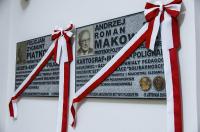WUT Masters of Cartography and Printing
Warsaw University of Technology Anniversary Celebrations is an opportunity to reflect back and appreciate those who earned particular merit for their service to the University. Undoubtedly, such distinguished figures include Prof. Felicjan Zygmunt Piątkowski and Prof. Andrzej Roman Makowski. The commemorative plaques celebrating them were unveiled on 16 November 2017.
Read more in the new article in the Buisness – Innovations – Technology series.
Felicjan Piątkowski became famous as the co-author of more than a dozen topographic maps of the post-war Poland. When he received his diploma from the Faculty of Geodesy, Warsaw University of Technology, in 1933, it seemed that he had a luminous career right ahead of him. But fate had a more twisted story for him.
On the front line and in the lab
Instead of gaining further professional experience, the young engineer was drafted for military service after the outbreak of WWII. He fought arms in hand but he also worked as part of the group responsible for creating maps for Warsaw Municipal Area during the occupation. Later, already in 1945, he established a cartographic lab at Warsaw Reconstruction Office, which was involved in developing maps for Warsaw, of course. It was Piątkowski who authored the Map of the Existing State of Warsaw (scale 1:10,000) and the Map of Destruction in Warsaw (scale 1:20,000). The website geoforum.pl describes the latter as one the most singular works of the kind. On the one hand, it was an important document showing the scale of wartime destruction (it was created from aerial photographs taken by the Soviet Army in 1945), and on the other, the map was distinguished by its modern graphic design.
But it was only the beginnings. In the years to come, Piątkowski would work on the input for other maps and atlases.
A pioneer
In 1946, he started his teaching career at Warsaw University of Technology and the Military University of Technology in Warsaw. Twenty-one years later he made his mark in Poland’s history of printing. His achievement was the establishment of the then first Printing Institute in the country and launching a degree program in Printing, a previously unknown field of study, at the WUT Faculty of Geodesy and Cartography. His scientific interests revolved around the publishing and reproduction process technology, map generalization studies and the issues of color scales for physical and thematic maps. He registered patents for 12 technological inventions. He was awarded the Polish Technology Champion Award in 1968 for one of them.
An author or co-author of hundreds of maps, atlases and handbooks, Professor Felicjan Piątkowski died in 2004 at 96.
An engineer and an artist
Andrzej Makowski achieved renown for his expertise in cartography, systemic mapping and map publishing and color theory. Similarly to Professor Piątkowski, he also graduated from the Faculty of Geodesy and Cartography, Warsaw University of Technology. As a matter of fact, he was the Professor’s student and then his associate. But before his career was in full swing, he complemented his engineering knowledge with a diploma from the Painting Department of the Academy of Fine Arts in Warsaw. That thorough and versatile background set him up for his career.
In 1966 Makowski defended his doctoral dissertation entitled “Estetyczny i użytkowy aspekt barwy na mapie” [Aesthetic and Utility Aspects of Color on Maps] (supervised by Professor Piątkowski himself). This was a milestone in building his professional standing and recognition. Ten years later, Makowski was already a proud holder of the Doctor of Science degree. According to his professional bio published at www.wydawca.com, his dissertation work entitled “Podstawa technologii barwy w kartografii” [Foundations of Color Technology in Cartography] introduced color parametrization processes to the methodology of mapping and map production.
Original technologies
Makowski is an important figure in the history of both cartography and printing in Poland. His interests spanned map publishing technology, map graphic design, map content and form perception and the color theory (as applied in cartography and printing). The scientist invented original technologies of graphic design in mapping from aerial and satellite photographs and for continuous tone reproduction of tonal-range imagery. He authored or co-authored hundreds of scientific papers, several handbooks and an international dictionary of cartographic terms. He directed the project to develop a model digital map, i.e. the topographic map of Poland scale 1:10,000 and a scientific paper entitled “System informacji topograficznej kraju. Teoretyczne i metodyczne opracowanie koncepcyjne” [System of Country’s Topographic Information. A Theoretical and Methodological Conceptual Framework] (a monograph edited by Makowski was released in 2005 winning the WUT Rector’s I Class Team Award).
Notably, the scientist was also a co-sponsor of academic courses in Printing Technology and the Printing Technology Section (at the Faculty of Geodesy and Cartography) at the University. Professor Makowski died in 2013 at 82.
Agnieszka Kapela
Promotion and Information Office
Sources:
Felicjan Zygmunt Piątkowski (1908–2004), http://geoforum.pl/?menu=46881,46884&page=persons&id=56, accessed on: 30 November 2017
Felicjan Zygmunt Piątkowski https://encyklopedia.pwn.pl/haslo/Piatkowski-Felicjan-Zygmunt;3956644.htm, accessed on: 30 November 2017
Prof. Andrzej Roman Makowski (1931–2013), http://www.wydawca.com.pl/index.php?s=info&kat=3&dzial=134&poddzial=0&id=9376, accessed on: 30 November 2017
Professor Andrzej Makowski’s Profile, http://kartografia.pwr.edu.pl/Joomla_SKP/index.php?option=com_content&view=article&id=168:nekrologam&catid=1:komunikaty&Itemid=113, accessed on: 30 November 2017
Official unveiling of the plaques commemorating Professors Piątkowski and Makowski https://www.biuletyn.pw.edu.pl/Wydarzenia/Uroczystosc-odsloniecia-tablic-upamietniajacych-profesorow-Piatkowskiego-i-Makowskiego, accessed on: 30 November 2017








